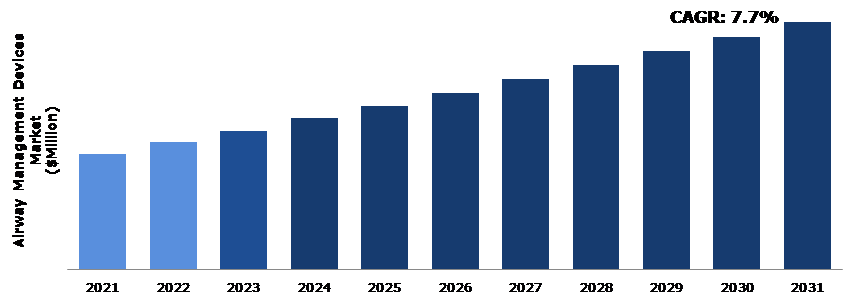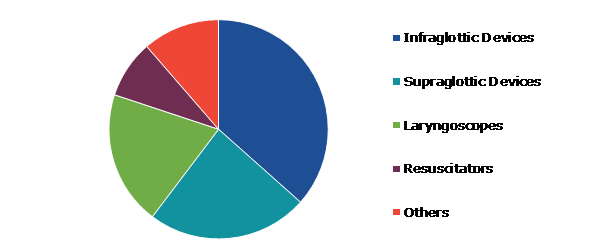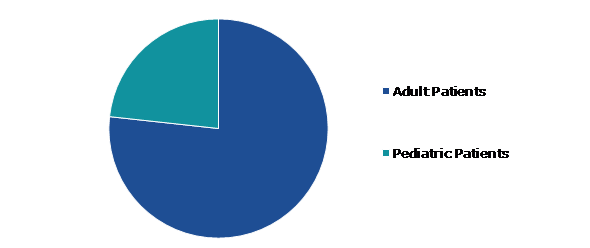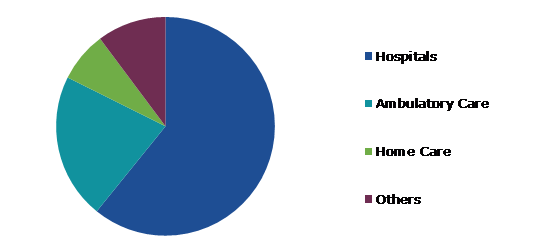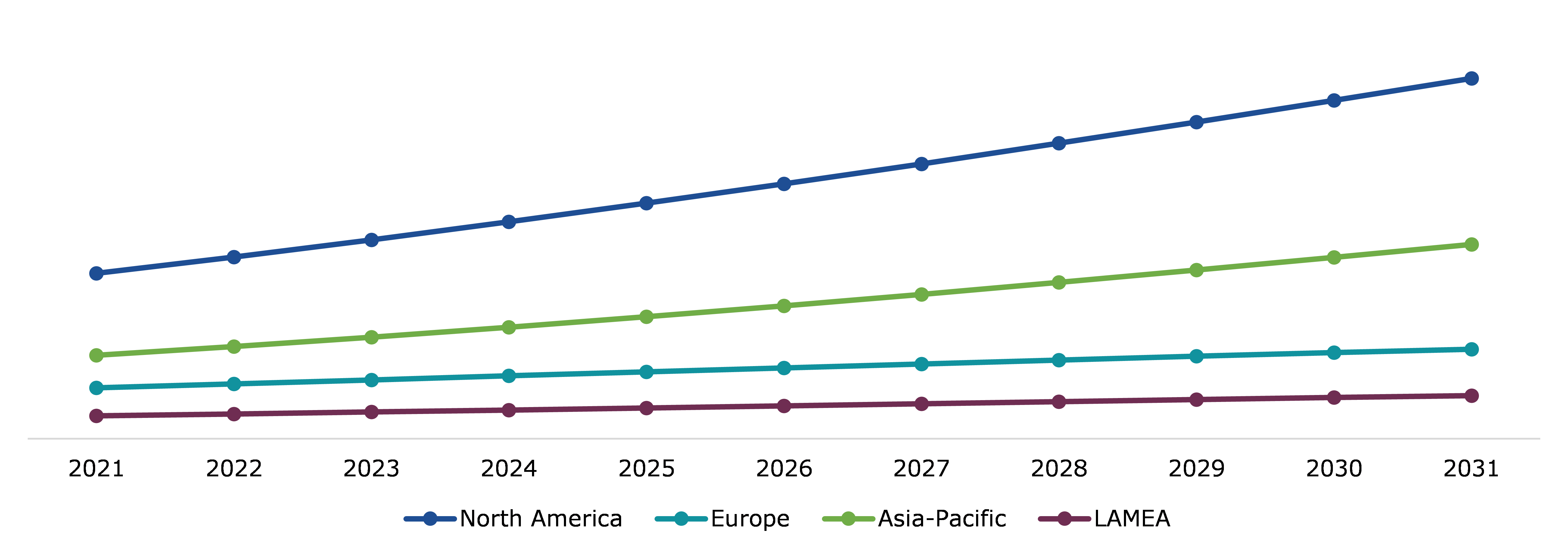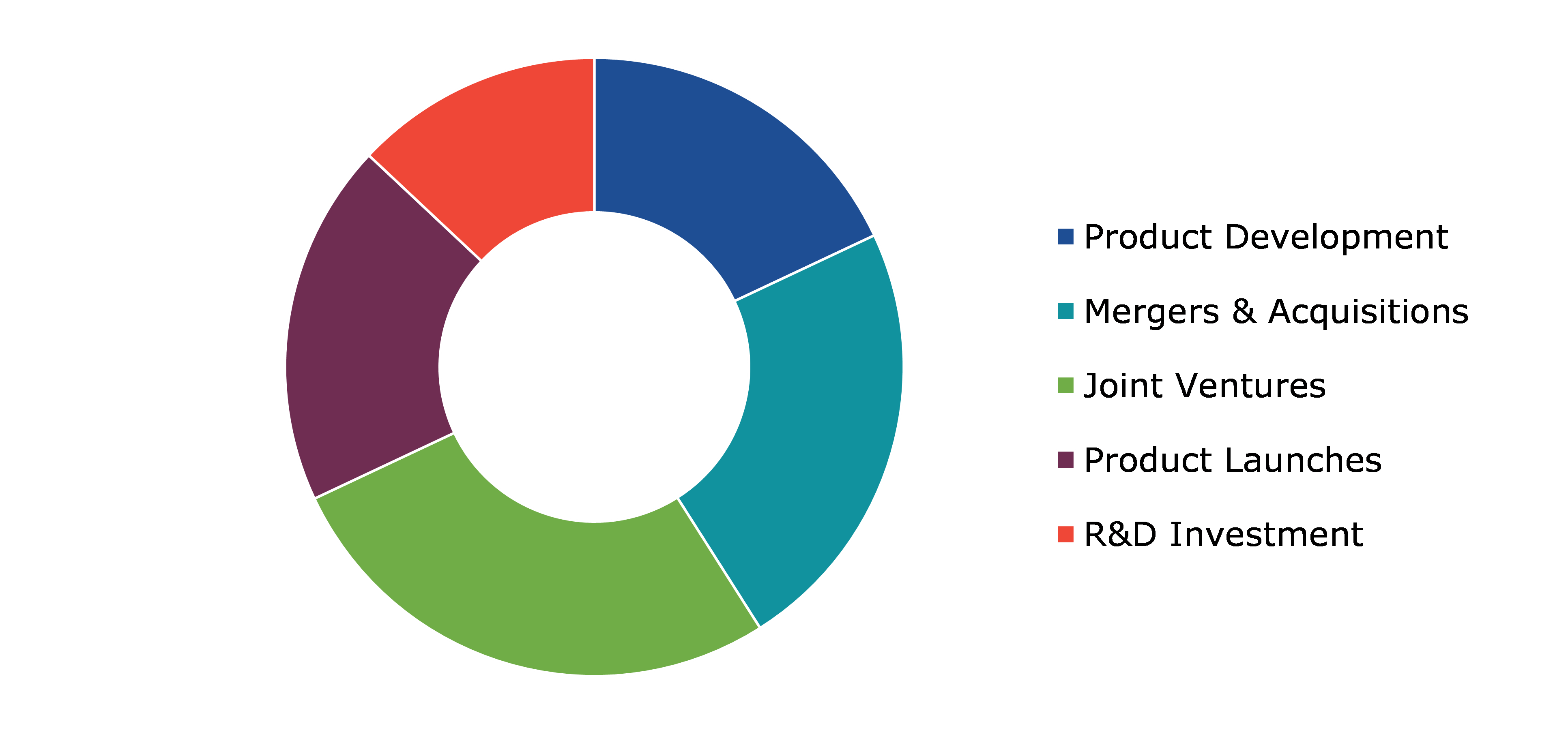Airway Management Devices Market Report
RA00081
Airway Management Devices Market by Device Type (Infraglottic Devices, Supraglottic Devices, Laryngoscopes, Resuscitators, and Others), Patient Age (Adult Patients and Pediatric Patients), and End User (Hospitals, Ambulatory Care, Home Care, and Others): Global Opportunity Analysis and Industry Forecast 2022–2031
Global Airway Management Devices Market Analysis
The global airway management devices market size was $1,961.50 million in 2021 and is predicted to grow with a CAGR of 7.7%, by generating revenue of $4,182.20 million by 2031.
Global Airway Management Devices Market Synopsis
Airway management is the assessment, planning, and series of medical procedures required to maintain or restore an individual’s ventilation, or breathing. By maintaining an open airway, air can flow from the nose and mouth into the lungs.
Patients may need airway care in a number of situations, from simple choking to complex airway obstruction. Several specific clinical symptoms need to be considered for airway management. Respiratory failure, low consciousness, sudden changes in mental status, active choking, and penetrating injuries are a few of them. A variety of airway management techniques may be used in hospitals, depending on the specific situation. Basic airway care uses non-invasive methods without the aid of specialized medical devices. Examples of techniques to remove foreign body airway obstruction include chest compressions, abdomen thrusts, and back blows. These factors are anticipated to boost the airway management devices market growth in the upcoming years.
However, the development of the global market for airway management devices is anticipated to be hampered by complications and restrictions related to airway management brought on by intubation and other reasons. The process of endotracheal intubation is practiced routinely in hospitals, although it carries risks and difficulties, such as the risk of injuries including tracheoesophageal fistulas and laryngotracheal stenosis.
The airway management devices market share growth has also been impacted by an increase in funds provided by the federal government to promote the adoption of airway management medical devices. The airway management devices market revenue also benefits from the increase in healthcare spending, improvements in the healthcare infrastructure, and an increase in the need for extended care delivery. Furthermore, with aging, the respiratory system changes geometrically, physiologically, and immunologically. The structural abnormalities include chest wall and thoracic spine deformities, which affect whole respiratory system compliance, resulting in airway inflammation. The high frequency of respiratory illnesses and increase in anesthetic usage as a result of more surgeries are predicted to drive demand for airway management devices and positively impact the growth of the global market. In addition, significant players are forming strategic alliances to expand the airway management device market, encouraged by technological breakthroughs. This factor is expected to create several opportunities for the key players in the airway management devices market growth.
According to regional analysis, the Asia-Pacific airway management devices market opportunity is predicted to grow with the highest CAGR during the forecast period. The market for airway management devices in Asia-Pacific is expected to witness growth due to an increase in the prevalence of chronic respiratory disorders and an increase in healthcare spending across the globe.
Airway Management Devices Overview
Airway management includes assessment, planning, and several medical procedures needed to maintain or restore patients' airways. Airway management device maintains an open pathway in patients, allowing gas exchange between the lungs and the atmosphere. Various products, such as oropharyngeal airways, nasopharyngeal airways, laryngeal mask airways, and tracheal incubation, are used in hospitals to provide airways to patients undergoing anesthesia procedures.
These devices are used in anesthesia, cardiopulmonary resuscitation, emergency medicine, neonatology, and other fields. It has applications in neonatology for managing the airway in babies, and the increase in the incidence of preterm birth may necessitate the need for airway management.
COVID-19 Impact on Global Airway Management Devices Market
The COVID-19 outbreak also resulted in a massive surge in demand for medical goods, such as personal protective equipment including gloves, masks, and safety glasses. As the number of COVID-19 cases increased globally, there was an increase in demand for medical supplies from both, healthcare providers and the general public to take precautions. The airway management device market revenue has a better opportunity of profiting from the increase in demand for medical supplies to ensure a sufficient and ongoing supply of personal protective equipment in the airway management devices market. In addition, the COVID-19 pandemic caused a spike in the number of patients being admitted to ICUs and emergency rooms. Patients with severe infections frequently need ventilators and other positive air pressure devices to treat respiratory failure or low oxygen saturation. Therefore, there is a higher need for airway management devices, particularly single-use ones. The number of patients requiring intubation using invasive airway management techniques increased due to the possibility of virus particles being aerosolized during non-invasive procedures,
Increase in Demand for Emergency and Intensive Care to Drive the Market Growth
Airway difficulties frequently occur in patients with infectious, persistent, and cardiac disorders, which require immediate medical treatment. Demand for airway management devices is rising as a result of the serval situations such as road accident victims and people suffering from other traumatic injuries. The frequency of visits to emergency rooms among adults in the U.S., who are 18 years of age and older, has increased by roughly 8.67% between 1997 and 2018, according to the Centers for Disease Control and Prevention’s (CDC) 2019 health data. The need for airway management devices is increasing globally due to a rise in the number of critically ill and trauma cases being admitted to emergency rooms and exhaustive care units. In addition, the COVID-19 pandemic has put a burden on the global healthcare system. Globally, admissions to emergency rooms and intensive care units have increased as a result of the pandemic's rapid spread. These factors are anticipated to boost the airway management devices market trend growth in future.
To know more about global airway management devices market drivers, get in touch with our analysts here.
Lack of Reimbursement Policies within Developing Countries Regarding Airway Management Devices to Hamper the Market Growth
Developing countries have low adoption rates for expensive airway management devices due to their ineffective healthcare insurance programs. For instance, the World Bank Group estimates that the average cost of healthcare in developing countries is roughly $80 per person annually (or $0.5 trillion). The increase in out-of-pocket expenses has negatively affected countries, making the population more vulnerable to chronic illness and COVID-19 outbreaks. According to the World Bank, High-Performance Health Financing for Universal Health Care, the funding gap needed to provide the general public with universal health coverage is expected to be $176 billion by 2030 (across the 54 poorest nations). Limited adoption of expensive medical devices such as video laryngoscopes and advanced surgical techniques in emerging regions is a major limitation for the airway management devices market share.
Increase in Demand for Single-use Airway Management Devices to Drive Excellent Opportunities
Airway management devices are among the medical devices used in various areas of the healthcare industry across a wide range of applications. Resuscitators, tracheostomy tubes, laryngoscope blades, and resuscitators endotracheal tubes are a few examples of single-use medical equipment that are widely used in healthcare facilities that provide value-based care services and treat critically ill patients with highly contagious illnesses such as H1N1 influenza or severe pneumonia. In addition, single-use devices have various advantages over reusable ones because they are already sanitized and ready for use, protecting patients from infections linked to medical care. The COVID-19 pandemic increased the usage of single-use airway management devices throughout healthcare facilities in an effort to comply with standards meant to stop the infection from spreading. Patients infected with COVID-19 who require breathing support are frequently intubated using tracheostomy tubes or single-use endotracheal tubes. Global demand for single-use airway management devices grows due to the increase in COVID-19 incidence.
To know more about global airway management devices market opportunities, get in touch with our analysts here.
Global Airway Management Devices Market, by Device Type
By device type, the market is divided into infraglottic devices, supraglottic devices, laryngoscopes, resuscitators, and others. Among these, the infraglottic devices segment accounted for the dominant market share in 2021 and is projected to be the fastest growing during the forecast period. However, the supraglottic devices segment accounted for the second highest market share in 2021.
Global Airway Management Devices Market Share, by Device Type, 2021
Source: Research Dive Analysis
The infraglottic devices segment accounted for a dominant market share in 2021. Infraglottic devices provide a conduit between the mouth and trachea, traveling through the glottis. There are a variety of infraglottic approaches available. There are several factors that determine the medical devices which are chosen for surgical technique, including the condition, availability of medical equipment, and surgeons’ skill level. A significant portion of the airway management devices market is devoted to intubation and positive air pressure ventilation for patients experiencing respiratory failure. After connecting with external breathing assistance systems, infraglottic devices like endotracheal tubes and tracheostomy tubes are used during intubation to rescue the airway and offer ventilation to patients. In addition, the incidence of acute respiratory failure is rising, which increases the demand for intubation techniques and infraglottic devices all over the region. Various factors such as the increase in the prevalence of chronic respiratory disorders, cardiovascular diseases, and respiratory tract infections are anticipated to boost the airway management devices market growth.
The supraglottic devices segment accounted for the second highest market share in 2021. These devices are utilized mostly in hospitals, ambulatory surgical centers, and other locations during the operation. Laryngeal mask airways (LMA) are the most frequently used on supraglottic devices. Laryngeal mask airways (LMAs) and similar devices are the most widely used supraglottic devices in the operating room, whereas other supraglottic devices such as combitube, laryngeal tube, and pharyngeal tube are more commonly utilized in the emergency department and for prehospital airway care. The LMA is made up of a hollow shaft or tube attached to a mask-like cuff that sits in the hypopharynx facing the glottis and has the tip at the esophageal inlet. The widespread usage of supraglottic instruments in a variety of clinical settings, such as indirect video laryngoscopes, is another factor boosting the market expansion.
Global Airway Management Devices Market, by Patient Age
By patient age, the market is divided into adult patients and pediatric patients. Among these, the adult patients segment accounted for the dominating market share in 2021.
Global Airway Management Devices Market Growth, by Patient Age, 2021
Source: Research Dive Analysis
The adult patients segment accounted for a dominating airway management devices market share in 2021. Most adult patients require to spend the majority of their time in hospitals for medical procedures, requiring ventilation and oxygenation. The majority of them, who visit hospitals for medical procedures, need ventilation and oxygenation. According to the Centers for Disease Control (CDC) and Prevention, COPD, congestive heart failure, and hypertension accounts for the majority of chronic disease visits to emergency rooms in the U.S. Increase in the adult population and rise in the occurrence of chronic diseases in geriatric patients are the key factors contributing to the growth of the adult patients segment.
Global Airway Management Devices Market, by End User
By end user, the market is divided into hospitals, ambulatory care, home care, and others. Among these, the hospitals segment accounted for the highest revenue share in 2021.
Global Airway Management Devices Market Forecast, by End User 2021
Source: Research Dive Analysis
The hospitals segment accounted for a dominant market share in 2021. An increase in government activities focused on improving safety, a rise in hospitals, healthcare infrastructure, and economic development, play a significant role in the hospital segment. For instance, groups like the American Society of Anesthesiologists (ASA) spread awareness about how important these devices are for managing problematic airways, which further increased the rate of adoption in hospitals. The ASA has also developed clinical practice recommendations and management techniques for difficult airway management and effective ventilation. These factors are anticipated to boost the growth of the hospitals sub-segment during the forecast period.
Global Airway Management Devices Market, Regional Insights
The airway management devices market is analyzed across North America, Europe, Asia-Pacific, and LAMEA.
Global Airway Management Devices Market Size & Forecast, by Region, 2021-2031 (USD Million)
Source: Research Dive Analysis
The Market for Airway Management Devices in North America to be the Most Dominant
The market for airway management devices is dominated by North America due to the prevalence of asthma and chronic obstructive pulmonary disease, as well as the growing elderly population. The U.S. Census Bureau reports that as of 2017, more than 50 million Americans aged 65 and older were at the highest risk of developing chronic conditions, which call for urgent ventilation.
In North America, two important countries where such medical devices have been widely adopted are the U.S. and Canada. The main causes of the increase in the need for airway management devices in North America are the rise in pollution rates and the increase in occurrences of respiratory problems, even in neonatal care. The U.S. market is projected to experience considerable expansion during the forecast period, due to favorable reimbursement policies, an increase in healthcare R&D spending, and a rise in the incidence of chronic diseases such as COPD. According to figures from the WHO, 12.7 to 14.7 million people in the U.S. have COPD. A strong presence of the medical industry in North America is going to aid the expansion of the airway management devices market share in the region.
Competitive Scenario in Global Airway Management Devices Market
Investment and agreement are common strategies followed by the major market players. For instance, in January 2022, ICU Medical Inc. announced that it has completed its acquisition of Smiths Medical from Smiths Group plc. The Smiths Medical business includes a syringe and ambulatory infusion devices, vascular access, and vital care products. When combined with ICU Medical’s existing businesses, the combined companies create a leading infusion therapy company with estimated pro forma combined revenues of approximately $2.5 billion.
Source: Research Dive Analysis
Some of the leading airway management devices market players are Medtronic, Smiths Medical, Inc., Teleflex Incorporated., KARL STORZ SE & Co. KG, Ambu A/S., Flexicare (Group) Limited, Intersurgical Ltd., SunMed, VYAIRE MEDICAL, INC., and Vbm Medizintechnik.
| Aspect | Particulars |
| Historical Market Estimations | 2020 |
| Base Year for Market Estimation | 2021 |
| Forecast Timeline for Market Projection | 2022-2031 |
| Geographical Scope | North America, Europe, Asia-Pacific, and LAMEA |
| Segmentation by Device Type |
|
| Segmentation by Patient Age |
|
| Segmentation by End User |
|
| Key Companies Profiled |
|
Q1. What is the size of the global airway management devices market?
A. The size of the global airway management devices market was over $1,961.50 million in 2021 and is projected to reach $4,182.20 million by 2031.
Q2. Which are the major companies in the airway management devices market?
A. AMBU A/S, Medtronic, Teleflex, and SunMed are some of the key players in the global airway management devices market.
Q3. Which region, among others, possesses greater investment opportunities in the near future?
A. Asia-Pacific possesses great investment opportunities for investors in the future.
Q4. What will be the growth rate of the Asia-Pacific airway management devices market?
A. The Asia-Pacific airway management devices market is anticipated to grow at a CAGR of 8.6% during the forecast period.
Q5. What are the strategies opted by the leading players in the market?
A. Agreement and investment are the two key strategies opted by the operating companies in the market.
Q6. Which companies are investing more on R&D practices?
A. Medtronic and Smiths Medical are investing more in R&D activities for developing new products and technologies.
1.Research Methodology
1.1.Desk Research
1.2.Real time insights and validation
1.3.Forecast model
1.4.Assumptions and forecast parameters
1.5.Market size estimation
1.5.1.Top-down approach
1.5.2.Bottom-up approach
2.Report Scope
2.1.Market definition
2.2.Key objectives of the study
2.3.Report overview
2.4.Market segmentation
2.5.Overview of the impact of COVID-19 on Global Airway Management Devices market
3.Executive Summary
4.Market Overview
4.1.Introduction
4.2.Growth impact forces
4.2.1.Drivers
4.2.2.Restraints
4.2.3.Opportunities
4.3.Market value chain analysis
4.3.1.List of raw material suppliers
4.3.2.List of manufacturers
4.3.3.List of distributors
4.4.Innovation & sustainability matrices
4.4.1.Technology matrix
4.4.2.Regulatory matrix
4.5.Porter’s five forces analysis
4.5.1.Bargaining power of suppliers
4.5.2.Bargaining power of consumers
4.5.3.Threat of substitutes
4.5.4.Threat of new entrants
4.5.5.Competitive rivalry intensity
4.6.PESTLE analysis
4.6.1.Political
4.6.2.Economical
4.6.3.Social
4.6.4.Technological
4.6.5.Environmental
4.7.Impact of COVID-19 on Airway Management Devices market
4.7.1.Pre-covid market scenario
4.7.2.Post-covid market scenario
5.Airway Management Devices Market Analysis, by Device Type
5.1.Overview
5.2.Infraglottic Devices
5.2.1.Definition, key trends, growth factors, and opportunities, 2021-2031
5.2.2.Market size analysis, by region, 2021-2031
5.2.3.Market share analysis, by country, 2021-2031
5.3.Supraglottic Devices
5.3.1.Definition, key trends, growth factors, and opportunities, 2021-2031
5.3.2.Market size analysis, by region, 2021-2031
5.3.3.Market share analysis, by country, 2021-2031
5.4.Laryngoscopes
5.4.1.Definition, key trends, growth factors, and opportunities, 2021-2031
5.4.2.Market size analysis, by region, 2021-2031
5.4.3.Market share analysis, by country, 2021-2031
5.5.Resuscitators
5.5.1.Definition, key trends, growth factors, and opportunities, 2021-2031
5.5.2.Market size analysis, by region, 2021-2031
5.5.3.Market share analysis, by country, 2021-2031
5.6.others
5.6.1.Definition, key trends, growth factors, and opportunities, 2021-2031
5.6.2.Market size analysis, by region, 2021-2031
5.6.3.Market share analysis, by country, 2021-2031
5.7.Research Dive Exclusive Insights
5.7.1.Market attractiveness, 2021-2031
5.7.2.Competition heatmap, 2021-2031
6.Airway Management Devices Market, by Patient Age
6.1.Adult Patients
6.1.1.Definition, key trends, growth factors, and opportunities, 2021-2031
6.1.2.Market size analysis, by region, 2021-2031
6.1.3.Market share analysis, by country, 2021-2031
6.2.Pediatric Patients
6.2.1.Definition, key trends, growth factors, and opportunities, 2021-2031
6.2.2.Market size analysis, by region, 2021-2031
6.2.3.Market share analysis, by country, 2021-2031
6.3.Research Dive Exclusive Insights
6.3.1.Market attractiveness, 2021-2031
6.3.2.Competition heatmap, 2021-2031
7.Airway Management Devices Market Analysis, by End User
7.1.Hospitals
7.1.1.Definition, key trends, growth factors, and opportunities, 2021-2031
7.1.2.Market size analysis, by region, 2021-2031
7.1.3.Market share analysis, by country, 2021-2031
7.2.Ambulatory Care
7.2.1.Definition, key trends, growth factors, and opportunities, 2021-2031
7.2.2.Market size analysis, by region, 2021-2031
7.2.3.Market share analysis, by country, 2021-2031
7.3.Home Care
7.3.1.Definition, key trends, growth factors, and opportunities, 2021-2031
7.3.2.Market size analysis, by region, 2021-2031
7.3.3.Market share analysis, by country, 2021-2031
7.4.Others
7.4.1.Definition, key trends, growth factors, and opportunities, 2021-2031
7.4.2.Market size analysis, by region, 2021-2031
7.4.3.Market share analysis, by country, 2021-2031
7.5.Research Dive Exclusive Insights
7.5.1.Market attractiveness, 2021-2031
7.5.2.Competition heatmap, 2021-2031
8.Airway Management Devices Market, by Region
8.1.North America
8.1.1.U.S.
8.1.1.1.Market size analysis, by Device Type, 2021-2031
8.1.1.2.Market size analysis, by Patient Age, 2021-2031
8.1.1.3.Market size analysis, by End User, 2021-2031
8.1.2.Canada
8.1.2.1.Market size analysis, by Device Type, 2021-2031
8.1.2.2.Market size analysis, by Patient Age, 2021-2031
8.1.2.3.Market size analysis, by End User, 2021-2031
8.1.3.Mexico
8.1.3.1.Market size analysis, by Device Type, 2021-2031
8.1.3.2.Market size analysis, by Patient Age, 2021-2031
8.1.3.3.Market size analysis, by End User, 2021-2031
8.1.4.Research Dive Exclusive Insights
8.1.4.1.Market attractiveness, 2021-2031
8.1.4.2.Competition heatmap, 2021-2031
8.2.Europe
8.2.1.Germany , 2021-2031
8.2.1.1.Market size analysis, by Device Type, 2021-2031
8.2.1.2.Market size analysis, by Patient Age, 2021-2031
8.2.1.3.Market size analysis, by End User, 2021-2031
8.2.2.UK
8.2.2.1.Market size analysis, by Device Type, 2021-2031
8.2.2.2.Market size analysis, by Patient Age, 2021-2031
8.2.2.3.Market size analysis, by End User, 2021-2031
8.2.3.France
8.2.3.1.Market size analysis, by Device Type, 2021-2031
8.2.3.2.Market size analysis, by Patient Age, 2021-2031
8.2.3.3.Market size analysis, by End User, 2021-2031
8.2.4.Spain
8.2.4.1.Market size analysis, by Device Type, 2021-2031
8.2.4.2.Market size analysis, by Patient Age, 2021-2031
8.2.4.3.Market size analysis, by End User, 2021-2031
8.2.5.Italy
8.2.5.1.Market size analysis, by Device Type, 2021-2031
8.2.5.2.Market size analysis, by Patient Age, 2021-2031
8.2.5.3.Market size analysis, by End User, 2021-2031
8.2.6.Rest of Europe
8.2.6.1.Market size analysis, by Device Type, 2021-2031
8.2.6.2.Market size analysis, by Patient Age, 2021-2031
8.2.6.3.Market size analysis, by End User, 2021-2031
8.2.7.Research Dive Exclusive Insights
8.2.7.1.Market attractiveness, 2021-2031
8.2.7.2.Competition heatmap, 2021-2031
8.3.Asia-Pacific
8.3.1.China
8.3.1.1.Market size analysis, by Device Type, 2021-2031
8.3.1.2.Market size analysis, by Patient Age, 2021-2031
8.3.1.3.Market size analysis, by End User, 2021-2031
8.3.2.Japan
8.3.2.1.Market size analysis, by Device Type, 2021-2031
8.3.2.2.Market size analysis, by Patient Age, 2021-2031
8.3.2.3.Market size analysis, by End User, 2021-2031
8.3.3.India
8.3.3.1.Market size analysis, by Device Type, 2021-2031
8.3.3.2.Market size analysis, by Patient Age, 2021-2031
8.3.3.3.Market size analysis, by End User, 2021-2031
8.3.4.Australia
8.3.4.1.Market size analysis, by Device Type, 2021-2031
8.3.4.2.Market size analysis, by Patient Age, 2021-2031
8.3.4.3.Market size analysis, by End User, 2021-2031
8.3.5.South Korea
8.3.5.1.Market size analysis, by Device Type, 2021-2031
8.3.5.2.Market size analysis, by Patient Age, 2021-2031
8.3.5.3.Market size analysis, by End User, 2021-2031
8.3.6.Rest of Asia-Pacific
8.3.6.1.Market size analysis, by Device Type, 2021-2031
8.3.6.2.Market size analysis, by Patient Age, 2021-2031
8.3.6.3.Market size analysis, by End User, 2021-2031
8.3.7.Research Dive Exclusive Insights
8.3.7.1.Market attractiveness, 2021-2031
8.3.7.2.Competition heatmap, 2021-2031
8.4.LAMEA
8.4.1.Brazil
8.4.1.1.Market size analysis, by Device Type, 2021-2031
8.4.1.2.Market size analysis, by Patient Age, 2021-2031
8.4.1.3.Market size analysis, by End User, 2021-2031
8.4.2.Saudi Arabia
8.4.2.1.Market size analysis, by Device Type, 2021-2031
8.4.2.2.Market size analysis, by Patient Age, 2021-2031
8.4.2.3.Market size analysis, by End User, 2021-2031
8.4.3.UAE
8.4.3.1.Market size analysis, by Device Type, 2021-2031
8.4.3.2.Market size analysis, by Patient Age, 2021-2031
8.4.3.3.Market size analysis, by End User, 2021-2031
8.4.4.South Africa
8.4.4.1.Market size analysis, by Device Type, 2021-2031
8.4.4.2.Market size analysis, by Patient Age, 2021-2031
8.4.4.3.Market size analysis, by End User, 2021-2031
8.4.5.Rest of LAMEA
8.4.5.1.Market size analysis, by Device Type, 2021-2031
8.4.5.2.Market size analysis, by Patient Age, 2021-2031
8.4.5.3.Market size analysis, by End User, 2021-2031
8.4.6.Research Dive Exclusive Insights
8.4.6.1.Market attractiveness, 2021-2031
8.4.6.2.Competition heatmap, 2021-2031
9.Competitive Landscape
9.1.Top winning strategies, 2021
9.1.1.By strategy
9.1.2.By year
9.2.Strategic overview
9.3.Market share analysis, 2021
10.Company Profiles
10.1. Medtronic
10.1.1.Overview
10.1.2.Business segments
10.1.3.Product portfolio
10.1.4.Financial performance
10.1.5.Recent developments
10.1.6.SWOT analysis
10.2.Smiths Medical, Inc.
10.2.1.Overview
10.2.2.Business segments
10.2.3.Product portfolio
10.2.4.Financial performance
10.2.5.Recent developments
10.2.6.SWOT analysis
10.3.Teleflex Incorporated.
10.3.1.Overview
10.3.2.Business segments
10.3.3.Product portfolio
10.3.4.Financial performance
10.3.5.Recent developments
10.3.6.SWOT analysis
10.4. KARL STORZ SE & Co. KG
10.4.1.Overview
10.4.2.Business segments
10.4.3.Product portfolio
10.4.4.Financial performance
10.4.5.Recent developments
10.4.6.SWOT analysis
10.5.Ambu A/S.
10.5.1.Overview
10.5.2.Business segments
10.5.3.Product portfolio
10.5.4.Financial performance
10.5.5.Recent developments
10.5.6.SWOT analysis
10.6.Flexicare (Group) Limited
10.6.1.Overview
10.6.2.Business segments
10.6.3.Product portfolio
10.6.4.Financial performance
10.6.5.Recent developments
10.6.6.SWOT analysis
10.7.Intersurgical Ltd
10.7.1.Overview
10.7.2.Business segments
10.7.3.Product portfolio
10.7.4.Financial performance
10.7.5.Recent developments
10.7.6.SWOT analysis
10.8.SunMed
10.8.1.Overview
10.8.2.Business segments
10.8.3.Product portfolio
10.8.4.Financial performance
10.8.5.Recent developments
10.8.6.SWOT analysis
10.9.VYAIRE MEDICAL, INC.
10.9.1.Overview
10.9.2.Business segments
10.9.3.Product portfolio
10.9.4.Financial performance
10.9.5.Recent developments
10.9.6.SWOT analysis
10.10.Vbm Medizintechnik.
10.10.1.Overview
10.10.2.Business segments
10.10.3.Product portfolio
10.10.4.Financial performance
10.10.5.Recent developments
10.10.6.SWOT analysis
11.Appendix
11.1.Parent & peer market analysis
11.2.Premium insights from industry experts
11.3.Related reports
Over the last 25 years, there have been numerous advancements in the safe management of the airway. In anaesthetic practice, securing the airway quickly and safely is essential. An airway management device serves as the most essential interface between the patient's lungs and the breathing system. Airway management allows gas exchange, prevents the lung from injuries, and enables various therapies.
A group of surgical treatments known as airway management devices are employed to maintain patients' airways open. Patients have safeguarded an open pathway with the use of this device, allowing for gas exchange between their lungs and the environment. For patients undergoing anaesthesia operations in hospitals, a variety of products, including nasopharyngeal airways, oropharyngeal airways, tracheal incubation, and laryngeal mask airways are used to provide airways. These instruments are used in many fields, such as cardiopulmonary resuscitation, emergency medicine, neonatology, and many more. The global airway management devices market is expanding at a rapid pace due to the increasing need for emergency care for illnesses that last for a long time as well as prolonged treatments associated with lung diseases in adults and children.
Newest Insights in the Airway Management Devices Market
The high occurrence of road accidents and other traumatic injuries coupled with a rise in anaesthesia usage in various surgical treatments are anticipated to drive the demand for airway management devices. As per a report by Research Dive, the global airway management devices market is expected to surpass a revenue of $4,182.20 million in the 2022-2031 timeframe, growing with a CAGR of 7.7%. The North America region is expected to perceive foremost and dominant growth in the years to come. This is owing to the growing occurrence of chronic obstructive pulmonary diseases and asthma, as well as the increasing ageing population in the region.
How are Market Players Responding to the Rising Demand for Airway Management Devices?
Market players are greatly investing in ground-breaking research and inventions to cater for the increasing need for new and advanced airway management devices. Some of the foremost players in the airway management devices market are Smiths Medical, Inc., Medtronic, Teleflex Incorporated., KARL STORZ SE & Co. KG, Ambu A/S., Flexicare (Group) Limited, Intersurgical Ltd., SunMed, Vbm Medizintechnik, VYAIRE MEDICAL, INC., and others. These players are focused on planning and formulating strategies such as mergers and acquisitions, collaborations, novel advances, and partnerships to reach a noteworthy position in the global market.
For instance,
- In April 2021, Smiths Medical, a company that manufactures, develops, and sells innovative medical products, launched an acapella choice blue vibratory PEP therapy system intended to help in the removal of secretions for patients who have chronic obstructive pulmonary disease (COPD), cystic fibrosis, lung disorders with secretory problems, asthma, and atelectasis.
- In May 2021, Medtronic, a global leader in medical technology, solutions, and services, launched the SonarMed airway monitoring device to monitor any ETT (endotracheal tube) position and obstruction for infants and newborns.
- In October 2022, AirPhysio, a leading respiratory device maker, joined hands with Medsmart, a foremost distributor in the line of healthcare equipment, to make AirPhysio devices available in India. AirPhysio is a respiratory device that uses Oscillating Positive Expiratory Pressure (OPEP) to naturally improve breathing process.
COVID-19 Impact on the Global Airway Management Devices Market
The unpredicted rise of the coronavirus pandemic in 2020 has positively impacted the global airway management devices market. During the pandemic period, there was a rise in the need for medical goods from both the general people and healthcare professionals to take safety measures. The demand for airway management devices increased significantly during the pandemic, as lung disorders and other respiratory issues increased magnificently. In addition, a greater number of patients were admitted to emergency rooms and ICUs as a result of the COVID-19 pandemic. Ventilators and other positive air pressure devices were widely used to treat low oxygen saturation or respiratory failure in patients with severe illnesses. All these factors indicate that the global airway management devices market growth is anticipated to fuel in the upcoming years.
Personalize this research
- Triangulate with your own data
- Request your format and definition
- Get a deeper dive on a specific application, geography, customer or competitor
- + 1-888-961-4454 Toll - Free
- support@researchdive.com

